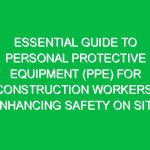Fall prevention is a critical aspect of Health, Safety, and Environment (HSE) management that demands attention and action. In various industries, especially construction, manufacturing, and healthcare, falls are among the leading causes of serious work-related injuries and deaths. However, with the right strategies and a commitment to safety culture, these incidents can be significantly reduced, if not entirely prevented. This article explores essential strategies for enhancing HSE outcomes through effective fall prevention measures.
Understanding the Importance of Fall Prevention
Fall prevention is not just about compliance with safety regulations; it’s about protecting workers, sustaining productivity, and fostering a safe working environment. A fall can result in severe injuries, such as fractures, head injuries, and even fatalities. Beyond the human cost, falls also lead to financial losses due to medical expenses, compensation claims, and lost work hours. Therefore, mastering fall prevention is crucial for the well-being of employees and the overall success of any organization.
The Role of Risk Assessment in Fall Prevention
Effective fall prevention begins with a thorough risk assessment. Identifying potential fall hazards, such as unprotected edges, slippery surfaces, and unstable working platforms, is the first step in mitigating risks. A comprehensive risk assessment also considers the task, the individual performing it, the equipment used, and the environment. This proactive approach enables organizations to implement targeted measures to prevent falls.
Strategies for Enhancing HSE Outcomes through Fall Prevention
Enhancing HSE outcomes requires a multifaceted approach to fall prevention. Here are some key strategies that organizations can adopt:
1. Implementing Engineering Controls
Engineering controls involve modifying the workplace to eliminate or reduce fall hazards. This can include installing guardrails, safety nets, and fall arrest systems. Designing work processes to minimize the need for working at heights is also an effective strategy. By prioritizing engineering controls, organizations can create a safer environment that inherently reduces the risk of falls.
2. Providing Personal Protective Equipment (PPE)
When engineering controls are not feasible, providing appropriate Personal Protective Equipment (PPE) is essential. This includes safety harnesses, lanyards, and other fall protection gear. It’s crucial that employees are trained on the correct use, maintenance, and inspection of PPE to ensure its effectiveness in preventing falls.
3. Fostering a Safety Culture
A strong safety culture is the backbone of effective fall prevention. This involves creating an environment where safety is everyone’s responsibility, and employees feel empowered to report hazards and participate in safety initiatives. Regular safety meetings, training sessions, and awareness campaigns can help foster a culture of safety and encourage proactive behaviors among employees.
4. Conducting Regular Training and Drills
Education and training are vital components of fall prevention. Regular training sessions should cover the identification of fall hazards, the use of fall protection equipment, and emergency response procedures. Conducting drills can also help employees practice what they’ve learned in a controlled environment, enhancing their readiness in case of an actual fall incident.
5. Continuous Monitoring and Improvement
Fall prevention is an ongoing process. Continuous monitoring of the workplace for new or evolving hazards is essential. Likewise, investigating fall incidents and near misses can provide valuable insights for improving safety measures. Organizations should also stay updated on the latest safety technologies and best practices in fall prevention to continually enhance their HSE outcomes.
Key Takeaways for Mastering Fall Prevention
Mastering fall prevention is crucial for safeguarding employees and achieving optimal Health, Safety, and Environment (HSE) outcomes. By understanding the importance of fall prevention and implementing comprehensive strategies, organizations can significantly reduce the risk of falls. Key strategies include conducting thorough risk assessments, implementing engineering controls, providing appropriate PPE, fostering a safety culture, conducting regular training and drills, and engaging in continuous monitoring and improvement.
Remember, fall prevention is not a one-time effort but a continuous commitment to safety. By prioritizing these strategies, organizations can create a safer work environment, protect their employees, and enhance their overall HSE performance.
Summary of Key Points
- Fall prevention is essential for protecting workers and sustaining productivity.
- Conducting a thorough risk assessment is the first step in identifying and mitigating fall hazards.
- Implementing engineering controls can significantly reduce the risk of falls by modifying the workplace.
- Providing appropriate Personal Protective Equipment (PPE) is crucial when engineering controls are not feasible.
- Fostering a safety culture encourages proactive safety behaviors among employees.
- Regular training and drills enhance employees’ knowledge and preparedness for preventing falls.
- Continuous monitoring and improvement are key to adapting to new hazards and enhancing safety measures.
In conclusion, mastering fall prevention is a vital aspect of enhancing Health, Safety, and Environment (HSE) outcomes. By implementing these essential strategies, organizations can not only comply with safety regulations but also create a safer, more productive work environment for all.


